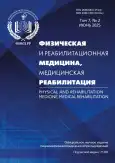Interval Hypoxia-Hyperoxia Therapy as a Method of Treating Patients with Chronic Critical Illness Caused by Severe Brain Damage
- 作者: Ilyina A.A.1,2, Petrova M.V.1,2, Grechko A.V.1,2, Ilyin D.V.1, Spirina G.K.3
-
隶属关系:
- Federal Research and Clinical Center of Intensive Care Medicine and Rehabilitology
- Peoples’ Friendship University of Russia
- AsFor Group
- 期: 卷 7, 编号 2 (2025)
- 页面: 154-163
- 栏目: CASE REPORT
- URL: https://bakhtiniada.ru/2658-6843/article/view/314427
- DOI: https://doi.org/10.36425/rehab683401
- EDN: https://elibrary.ru/ZLPOEM
- ID: 314427
如何引用文章
全文:
详细
The term “chronic critical illness” was first coined in 1985 by researchers at Stanford University School of Medicine in an article with the provocative headline “Save or let die?” The authors described a unique category of patients that stood out among the general population of patients in intensive care units. These patients, who received a full range of intensive care, did not die, but also did not achieve recovery for weeks, months, or even years after an acute Injury. This research opened doors for further study.
National and foreign sources show that patients with chronic critical illness comprise 5–20% of intensive care unit patients. Despite intensive treatment and rehabilitation measures, most of these patients eventually develop homeostasis disorders and complications, leading to multiple organ failure and death.
This article presents an intermittent hypoxia-hyperoxia therapy case study for a patient with the chronic disorder of consciousness. The patient completed two weeks of intensive care therapy at the Scientific Research Institute of rehabilitation named after Prof. Pryanikova I.V. of the Federal Research and Clinical Center of Intensive Care Medicine and Rehabilitology. Metered-dose intermittent hypoxia-hyperoxia therapy training improved the patient’s adaptation and reduced neurological deficits as a part of comprehensive rehabilitation.
Intermittent hypoxic-hyperoxia therapy shows potential in the intensive care unit patient treatment and in rehabilitation.
作者简介
Anna Ilyina
Federal Research and Clinical Center of Intensive Care Medicine and Rehabilitology; Peoples’ Friendship University of Russia
编辑信件的主要联系方式.
Email: shishova-1992@mail.ru
ORCID iD: 0000-0001-6188-870X
SPIN 代码: 1200-3966
俄罗斯联邦, Moscow; Moscow
Marina Petrova
Federal Research and Clinical Center of Intensive Care Medicine and Rehabilitology; Peoples’ Friendship University of Russia
Email: mpetrova@fnkcrr.ru
ORCID iD: 0000-0003-4272-0957
SPIN 代码: 9132-4190
MD, Dr. Sci. (Medicine), Professor
俄罗斯联邦, Moscow; MoscowAndrey Grechko
Federal Research and Clinical Center of Intensive Care Medicine and Rehabilitology; Peoples’ Friendship University of Russia
Email: avgrechko@fnkcrr.ru
ORCID iD: 0000-0003-3318-796X
SPIN 代码: 4865-8723
MD, Dr. Sci. (Medicine), Professor, Academician of the Russian Academy of Sciences
俄罗斯联邦, Moscow; MoscowDmitry Ilyin
Federal Research and Clinical Center of Intensive Care Medicine and Rehabilitology
Email: lionglass45@gmail.com
ORCID iD: 0009-0007-0997-7773
俄罗斯联邦, Moscow
Galina Spirina
AsFor Group
Email: g.spirina@aimediq.com
ORCID iD: 0000-0002-9574-5931
俄罗斯联邦, Moscow
参考
- Girard K, Raffin TA. The chronically critically ill: To save or let die? Respir Care. 1985;30(5):339–347.
- Parfenov AL, Razzhivin VP, Petrova MV. Chronic critical illness: Current aspects of the problem (review). Sovrem Tekhnologii Med. 2022;14(3):70–81. doi: 10.17691/stm2022.14.3.08
- Carson SS, Bach PB. The epidemiology and costs of chronic critical illness. Crit Care Clin. 2002;18(3):461–476. doi: 10.1016/s0749-0704(02)00015-5
- Hawkins RB, Raymond SL, Stortz JA, et al. Chronic critical illness and the persistent inflammation, immunosuppression, and catabolism syndrome. Front Immunol. 2018;9:1511. doi: 10.3389/fimmu.2018.01511
- Madrid RA, McGee W. Value, chronic critical illness, and choosing wisely. J Intensive Care Med. 2019;34(8):609–614. doi: 10.1177/0885066618790942
- Glazachev OS, Lyamina NP, Spirina GK. Intermittent hypoxic conditioning: experience and potential in cardiac rehabilitation programs. Russian journal of Cardiology. 2021;26(5):156–162. doi: 10.15829/1560-4071-2021-4426 EDN: NDKICG
- Navarrete-Opazo A, Mitchell GS. Therapeutic potential of intermittent hypoxia: A matter of dose. Am J Physiol Regul Integr Comp Physiol. 2014;307(10):R1181–1197. doi: 10.1152/ajpregu.00208.2014
- Patent RUS № RU 2799252 C1/25.03.2022. A method of increasing the level of consciousness of patients with chronic disorders of the level of consciousness. (In Russ.) Available at: https://patents.google.com/patent/RU2799252C1/ru EDN: ARGYAY
- Schega L, Peter B, Törpel A, et al. Effects of intermittent hypoxia on cognitive performance and quality of life in elderly adults: A pilot study. Gerontology. 2013;59(4):316–323. doi: 10.1159/000350927
- Serebrovska ZO, Xi L, Tumanovska LV, et al. Response of circulating inflammatory markers to intermittent hypoxia-hyperoxia training in healthy elderly people and patients with mild cognitive impairment. Life (Basel). 2022;12(3):432. doi: 10.3390/life12030432
- Syrkin AL, Glazachev OS, Kopylov FY, et al. Adaptation to intermittent hypoxia-hyperoxia in the rehabilitation of patients with ischemic heart disease: Exercise tolerance and quality of life. Kardiologiia. 2017;57(5):10–16. doi: 10.18565/cardio.2017.5.10-16 EDN: YPQJWX










